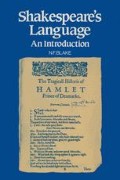Abstract
To study the language of a Shakespearian play means looking at many points of detail as well as the linguistic structure and background in the Elizabethan period. It should not be assumed that study of this kind will challenge accepted interpretations of a play, though naturally understanding some utterances correctly or even realising the possible interpretations which an utterance may have could affect our response to the tone of a scene or the make-up of a character. In general in the study of Shakespeare his language has been neglected by readers and editors. The efforts which the latter have put into understanding the typographical and bibliographical details of their texts have not been matched by any attempt to understand the language so that often linguistic emendations are made which seem unnecessary. However, it has to be admitted that there are limits to our understanding of the language, which may indeed have more than one possible interpretation. Generally the language contained more euphony and variety and less subordination than ours. It also had a different structure with fewer grammatical words. This aspect of the language is often overlooked because we attach more importance to meaning and vocabulary.
Preview
Unable to display preview. Download preview PDF.
Author information
Authors and Affiliations
Copyright information
© 1983 N. F. Blake
About this chapter
Cite this chapter
Blake, N.F. (1983). Conclusion. In: Shakespeare’s Language. Palgrave, London. https://doi.org/10.1007/978-1-349-17051-7_9
Download citation
DOI: https://doi.org/10.1007/978-1-349-17051-7_9
Publisher Name: Palgrave, London
Print ISBN: 978-0-333-28639-5
Online ISBN: 978-1-349-17051-7
eBook Packages: Palgrave Literature & Performing Arts CollectionLiterature, Cultural and Media Studies (R0)

